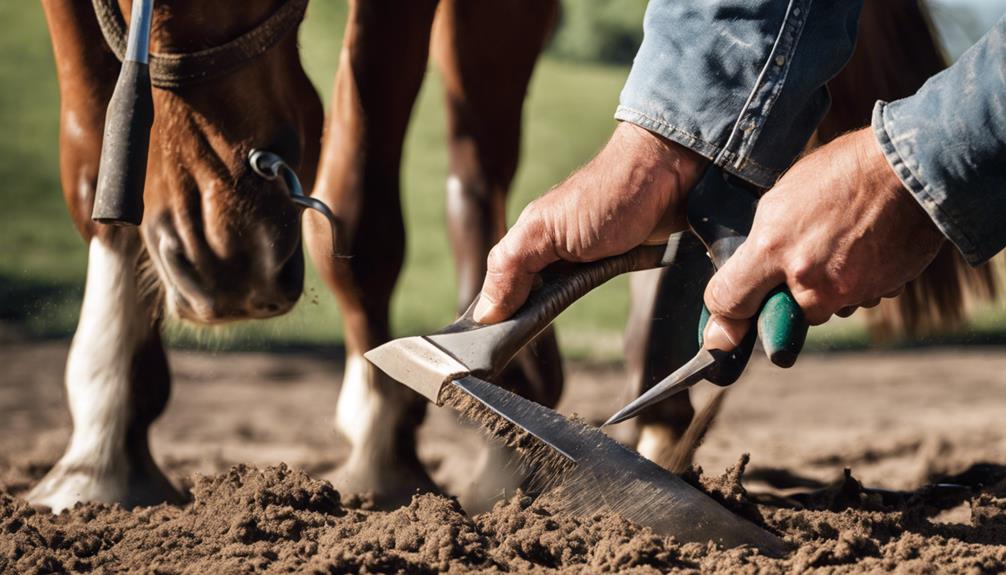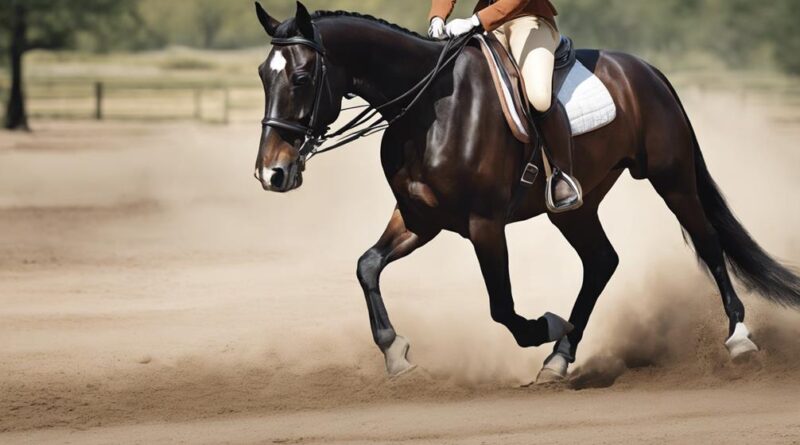Endurance Riding Training Essentials for Horses
Imagine your horse gracefully navigating through vast, rolling hills, their muscles working in perfect harmony with each step.
As you prepare for the challenges of endurance riding, understanding the essential elements that contribute to your horse's success becomes paramount.
From selecting the right terrain to honing their mental resilience, each aspect plays a crucial role in achieving peak performance.
Let's explore how these training essentials can elevate your horse's endurance capabilities and set them up for success in the long run.
Choosing the Right Terrain
When selecting the appropriate terrain for your endurance riding training, consider the impact it will have on your horse's performance. Terrain selection plays a crucial role in the success of your training sessions. The type of terrain you choose should match both your rider experience and your horse's preparation level.
Rider experience is a key factor when deciding on the terrain for your endurance training. Novice riders may find it challenging to navigate through rough or steep terrain, which could lead to accidents or injuries for both the rider and the horse. In contrast, experienced riders can handle more difficult trail conditions with better control and confidence. Therefore, it's essential to assess your own skill level before embarking on training sessions in varying terrains.
Furthermore, trail conditions directly impact your horse's performance during endurance riding. Uneven terrain, such as rocky paths or muddy tracks, can test your horse's agility and strength. It's crucial to gradually introduce your horse to different trail conditions to build up its endurance and resilience. Additionally, proper horse preparation, including conditioning exercises and regular health check-ups, is vital to ensure that your horse can handle the challenges posed by different terrains.
Building Cardiovascular Fitness
To enhance your horse's endurance riding performance, focus on boosting cardiovascular fitness through targeted training routines. Improving your horse's cardiovascular fitness is essential for excelling in endurance riding. Here are some key strategies to help you build your horse's cardiovascular endurance:
- Interval Training: Incorporate interval training sessions into your horse's workout routine. Alternating between bursts of high-intensity exercise and periods of rest will challenge your horse's cardiovascular system and improve its overall stamina.
- Performance Tracking: Keep a record of your horse's training sessions and performance metrics. Monitoring metrics like heart rate, recovery time, and speed can help you track improvements in cardiovascular fitness over time.
- Cross Training: Engage your horse in a variety of activities such as swimming or trotting to improve overall fitness levels. Cross-training helps prevent overuse injuries and keeps your horse mentally engaged.
- Hill Workouts: Include hill workouts in your training regimen to build strength and cardiovascular endurance. Climbing hills forces your horse to work harder, enhancing its cardiovascular capacity.
- Consistent Training: Stay consistent with your training routine to see lasting improvements in your horse's cardiovascular fitness. Regular exercise is key to building endurance and improving overall performance on the trail.
Implementing Proper Nutrition
Boost your horse's endurance riding performance by focusing on implementing proper nutrition to support their training efforts. A balanced diet is essential to ensure your horse has the energy and nutrients needed for long rides. Provide a mix of quality hay, grains, and fresh water daily to keep your horse in optimal condition. Additionally, consider incorporating dietary supplements to fill any nutritional gaps and support muscle function.
Hydration is key to success in endurance riding. Make sure your horse has access to clean, fresh water at all times, especially during training and rides. Electrolytes play a crucial role in maintaining proper hydration levels and muscle function. Consider offering electrolyte supplements before and after rides, particularly in hot weather or during intense training sessions.
To optimize your horse's performance, monitor their weight and body condition regularly. Adjust their diet as needed to ensure they're neither underfed nor overweight. Work closely with your veterinarian or equine nutritionist to develop a nutrition plan tailored to your horse's individual needs.
Developing Mental Endurance
Developing mental endurance in your horse is crucial for excelling in endurance riding. To ensure your horse is mentally prepared for the challenges of long rides, consider implementing visualization techniques and relaxation methods to strengthen the mind-body connection. Here are some essential tips to help improve your horse's mental endurance:
- Mental Preparation: Engage in mental preparation exercises before rides to help your horse focus and stay calm amidst distractions.
- Visualization Techniques: Encourage your horse to visualize successfully completing endurance rides, boosting their confidence and determination.
- Mind-Body Connection: Work on strengthening the mind-body connection through exercises that promote relaxation and reduce stress levels.
- Relaxation Methods: Teach your horse relaxation methods such as deep breathing or gentle stretches to alleviate tension and promote a sense of calm.
- Consistent Practice: Consistency is key; regularly practice mental endurance exercises to build your horse's resilience and ability to cope with the demands of endurance riding.
Focusing on Strength Training
Strengthen your horse's muscles through targeted strength training exercises to enhance endurance and performance in endurance riding. Strength training benefits your horse by improving muscle tone, increasing stamina, and reducing the risk of injuries during long rides. Incorporating strength training into your horse's workout routines is crucial for building the necessary physical foundation to tackle the challenges of endurance riding.
To reap the benefits of strength training, focus on exercises that target key muscle groups involved in endurance riding. Include exercises such as hill work, trot sets, canter intervals, and pole work to develop strength and endurance in your horse's legs and core. These workouts not only improve muscle strength but also help enhance your horse's overall agility and coordination.
A well-rounded strength training routine should also incorporate rest days to allow for muscle recovery and growth. Overtraining can lead to fatigue and potential injuries, so it's important to strike a balance between challenging workouts and adequate rest periods. By gradually increasing the intensity and duration of your horse's strength training sessions, you can steadily improve their muscular endurance and performance in endurance riding events.
Mastering Pacing Techniques
To optimize your horse's performance in endurance riding, mastering pacing techniques is essential for maintaining energy levels and achieving peak efficiency throughout long-distance rides. Proper pacing can make a significant difference in how well your horse endures the journey. Here are some key strategies to help you master pacing techniques:
- Breathing exercises: Encourage your horse to practice deep breathing exercises to enhance oxygen flow and reduce fatigue during the ride.
- Mental focus: Train your horse to stay focused and calm, preventing unnecessary energy expenditure from nervousness or distractions.
- Interval training: Incorporate interval training sessions to build your horse's stamina and teach them to pace themselves effectively.
- Stamina building: Gradually increase the length and intensity of your training rides to improve your horse's endurance over time.
- Consistent monitoring: Keep a close eye on your horse's vital signs and behavior during training to adjust pacing strategies accordingly.
Ensuring Proper Hoof Care

Proper hoof care plays a crucial role in maintaining your horse's overall health and performance during endurance riding. Regular trimming is essential to prevent issues such as overgrowth, cracks, or imbalances that could lead to discomfort or lameness. By scheduling routine trims every 6-8 weeks, you can ensure that your horse's hooves are in top condition for the demands of endurance riding.
In addition to trimming, proper shoeing is another key aspect of hoof care for endurance horses. Consult with a professional farrier to determine the best shoeing options for your horse based on factors like terrain, hoof conformation, and gait. Correct shoeing can provide additional support and protection, especially on challenging surfaces like rocky trails or hard-packed roads.
Remember that each horse is unique, so it's important to work closely with your farrier to develop a hoof care plan tailored to your horse's specific needs. Regularly inspect your horse's hooves for any signs of damage, and address any issues promptly to prevent them from escalating. By prioritizing proper hoof care through regular trimming and appropriate shoeing, you can help your horse stay sound and comfortable throughout your endurance riding training and competitions.
Monitoring Health and Recovery
Maintain peak performance by closely monitoring your horse's health and recovery throughout your endurance riding training. Tracking progress and adjusting your training regimen based on your horse's condition is crucial for success. Here are some essential tips to help you effectively monitor your horse's health and recovery:
- Regular Veterinary Check-ups: Schedule routine check-ups with your veterinarian to ensure your horse is in good health and address any concerns promptly.
- Monitor Vital Signs: Keep an eye on your horse's heart rate, respiratory rate, and temperature before and after training sessions to track their fitness level and recovery.
- Evaluate Body Condition: Regularly assess your horse's body condition score to ensure they're maintaining an ideal weight for optimal performance.
- Rest Intervals: Incorporate adequate rest intervals into your training schedule to prevent overtraining and allow for proper recovery.
- Hydration and Nutrition: Ensure your horse has access to clean water at all times and provide a balanced diet to support their energy needs during training.
Frequently Asked Questions
What Are Some Common Mistakes to Avoid When Training for Endurance Riding?
When training for endurance riding, avoid common mistakes like pushing too hard too soon. Patience is key. Focus on gradual progress and listen to your horse's cues.
Communication techniques play a vital role in understanding your horse's needs and capabilities. Avoid overtraining and ensure proper rest periods.
How Can Riders Improve Their Communication With Their Horses During Endurance Rides?
To improve communication with your horse on endurance rides, focus on your body language and cues. Pay attention to subtle signals and respond to your horse's cues promptly.
Build trust and connection by spending quality time together outside of training sessions. Understand your horse's behavior and preferences to communicate effectively during rides.
Are There Any Specific Supplements or Vitamins That Are Recommended for Horses Training for Endurance Riding?
When training your horse for endurance rides, it's important to consider their nutritional needs. Some recommended supplements for performance enhancers include electrolytes to keep them hydrated, joint supplements for mobility, and probiotics for digestion.
Always consult with your veterinarian to determine the best plan for your horse's specific needs. Remember, a well-balanced diet is key to keeping your equine partner in top shape for those long rides.
How Can Riders Prevent and Manage Injuries During Endurance Rides?
To prevent injuries during endurance rides, focus on proper warm-up routines and regular stretching. Stay hydrated and listen to your body's signals to avoid overexertion.
Utilize proper gear and equipment to reduce the risk of accidents. After rides, prioritize recovery management with rest, ice, and gentle exercises.
Regular vet check-ups and proper shoeing can also help prevent injuries in your horse. By being mindful and proactive, you can minimize the chances of injuries during endurance rides.
What Are Some Tips for Preparing for Extreme Weather Conditions During Endurance Rides?
When facing extreme weather conditions during endurance rides, remember to focus on gear selection and hydration strategies. Choose appropriate clothing and equipment to protect against harsh weather elements.
Stay hydrated by drinking water regularly and consider using electrolyte supplements for added support. Be prepared for any weather changes by carrying extra layers or rain gear.
Prioritize safety and comfort to ensure a successful ride in challenging conditions.
Conclusion
In conclusion, by focusing on the essentials of endurance riding training for your horse, you can ensure they're prepared for the physical and mental challenges of long-distance rides.
From choosing the right terrain to implementing proper nutrition and strength training, every aspect plays a crucial role in their success.
By incorporating these key elements into your training routine, you can help your horse reach their full potential and excel in endurance riding competitions.
